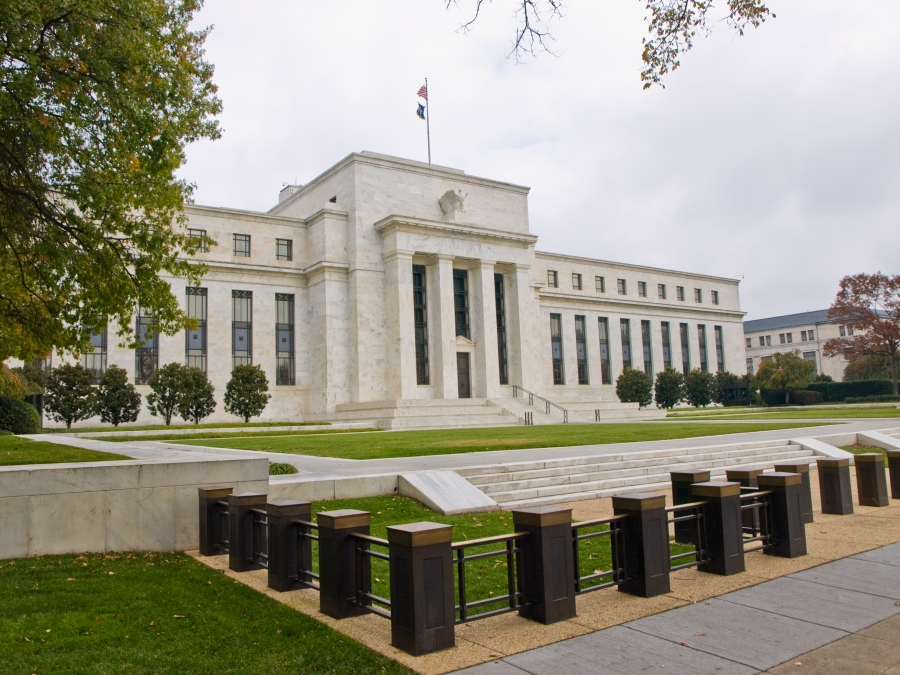Quantitative Easing and Its Effects
Federal Reserve Building, Washington DC Photo Credit: Flickr.com/wwarby
Despite its impact on our economic well-being, few people seem to know much about Quantitative Easing (QE). QE was a Federal Reserve monetary experiment, and not even the Keynesians running the Fed knew how it would come out. How then are ordinary people supposed to understand it? Yet understanding QE is important for all citizens, since it appears QE is doing very bad things to our economy. It may well be one partial explanation for the more than bad “recovery” we have had from the “Great Recession”.
Quantitative easing was inspired by a problem the Fed had when they found that driving real short-term interest rates down to zero did not appreciably stimulate economic growth. This Fed policy is called the Zero Interest Rate Policy, whose acronym ZIRP you may have seen. How bad were the results? Judge for yourself from the graph of GDP growth for three different recoveries below.The time axis shows years from the beginning of the respective recoveries. The blue curve is for the Reagan recovery, the red for the recovery from the Savings and Loan crisis of the late 1980s, and the yellow is for the current Obama recovery.

Image Credit: Wall Street Journal
A cursory examination shows the Obama recovery has never boasted GDP growth over 2.5% per year and has an average over the first six years of about 1.7%. See the post OMG!! This Economy Has Been Even Worse Than We Thought! for more discussion of Obama’s recovery.
From the start of the Great Recession in December 2007, approximately two years before the beginning of the Obama recovery curve in the graph, the Fed attempted the use of standard central bank methods to reduce the short-term interest rates. These operations were primarily the buying of short-term government bonds. By decreasing the number of such bonds in the market, the Fed drove up their price and therefore decreased their yield, the rate of return paid by government borrowers in the bond market. The decreased yield then becomes the short-term interest rate the next borrower would have to pay.
After doing all this, the Fed found after driving real short-term interest rates (nominal interest rates minus inflation) down to zero, there was little discernible economic growth. What more could they do? Up to that point in their history, the Fed had almost complete control over short-term interest rates but no control over long-term rates. Japan ran into this kind of problem first in the early 2000s. They reacted by buying long-term government bonds and asset-backed securities to lower long-term interest rates to zero, i.e. they implemented quantitative easing. The mechanism was identical to that used to lower short-term rates, except that long-term bonds and assets were bought, thereby lowering long-term rates.
In November 2008, the Federal Reserve began to emulate the Japanese central bank by buying up both long-term treasury bonds and mortgage-baced securities. In Wikipedia I found the following chart of U.S. Treasuries and mortgage-backed securities held by the Fed as a function of year.

Image Credit: Wikipedia Commons/Farcaster
The blue curve is for the Treasuries and red for the mortgage-backed securities The chart displays these assets with all maturity terms, but after November of 2008 the Treasuries and mortgage -backed securities bought were mostly long-term. As you can see from the chart, there were periods of QE acquisitions followed by periods of six months to a year of no QE acquisitions. In order of their occurrence, the periods of QE acquisitions are commonly called QE1, QE2, and QE3, respectively. At the height of QE, the Fed was pumping $85 billion of brand new dollars into the banks every month to buy these long-term assets. After a brief period of tapering the acquisitions, the Fed ended QE in October, 2014.
And how did it work? Did it succeed in being a Keynesian stimulus for economic growth? All you have to do is reappraise the graph of GDP growth during the Obama recovery to see it has had little, if any, effect on GDP growth. In recent months a rumble of discontent within the FOMC has given evidence of a possible schism within the Fed over the usefulness of QE, a schism suggested by our post Division in the Fed. In that post a link was given to a white paper by the vice president of the St. Louis Federal Reserve District Bank, Stephen D. Williamson that questioned the received wisdom on QE. Within that paper Williamson states,
Further there is no work, to my knowledge, that establishes a link from QE to the ultimate goals of the Fed – inflation and real economic activity.
I must hasten to explain the reference to inflation. Way back in time before stagflation in the U.S. in the late 1970s, Keynesians believed in a trade-off between the unemployment rate and inflation called the Phillips curve. If you were to do a least squares fit to 1960s data you would get the Phillips curve shown below.

Image Credit: econolib.org
During the 1970s Milton Friedman and the monetarist school of economics associated with him severely criticized the curve as being correct only in the short term. In an inflationary environment they claimed once people came to expect a particular level of inflation, they would demand and employers would give an extra increase in their wages to counteract that price inflation. This extra increase in wages would then generate additional price inflation, causing a positive feedback mechanism that would cause runaway inflation. Also, employers would eventually not be able to pass their extra wage costs on to the customers and have to lay-off workers and reduce production, causing economic stagnation. Friedman and the monetarists were proven right and the Keynesians wrong with the advent of stagflation in the late 1970s.
Nevertheless, as the plot of the Phillips curve implied by 1960s data above shows, one could still depend on a short-term adherence of the economy to a temporarily valid Phillips curve. This is what the Keynesians on the Fed were counting on with their QE and ZIRP programs. They would flood the system with new dollars, lower both the real short-term and long-term interest rates to zero, and thereby stimulate the economy into economic growth. In addition, by keeping most of these new dollars out of the economic system by luring most of it back into “excess reserves”, allowing new money to flow mostly into the stock market and mortgages, they hoped to limit the inflationary damage. Then they could halt the stimulation program before stagflation could hit,
It did not work! They were successful in holding inflation in check, but as we and Stephen D. Williamson already noted, no perceptible stimulation of GDP growth occurred. In addition QE has also set up serious problems for the future. The problem with keeping credit artificially cheap with low interest rates for an extended time is that it lowers the rate of new capital formation, which must come from new savings, either from individuals or from companies. But why should anyone save if interest rates are perpetually low? For an individual, low interest rates for a long time gives an incentive not just to spend, but to borrow and spend at the same time, since there is no reward for saving and little penalty for borrowing. The same is true for a company.
There was some leakage of QE money to the economic system in the 20% of QE money that was not put in excess reserves. The banks lent this money to their most credit-worthy customers which meant primarily large corporations and investment funds. Rather than invest the money in new productive capacity, corporations mostly used it to buy back their own stock. The hostile economic environment of the Obama administration was raising costs and reducing opportunities for profits, so the corporations had little incentive for such investments, and the revenues per share were falling. However, the companies could still make their stocks attractive in the market by reducing the total number of their shares outstanding through buy-backs, keeping their PEs low even with constant or falling revenues. And of course the investment funds also used the money they borrowed at zero real interest rates to buy stock for themselves. In this way the Fed has fueled a stock market asset bubble, that looks like it is about to burst. Similarly, in interaction with Obama administration mortgage policies, the Fed also appears to be fueling an incipient real-estate bubble identical to the one that caused the 2007-2008 financial crisis.
All of these historical experiences with Keynesian monetary stimulation suggest to me that the Fed’s mandates should be reduced to one: target an inflation rate of 0% to keep the value of the dollar constant. Then the Federal Reserve should adopt a monetary rule to reach this goal.
Views: 3,572






























